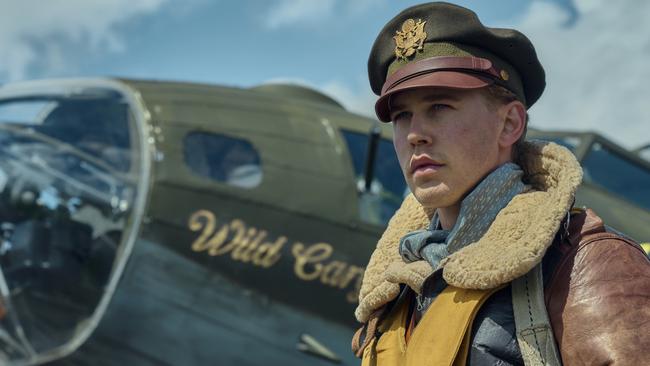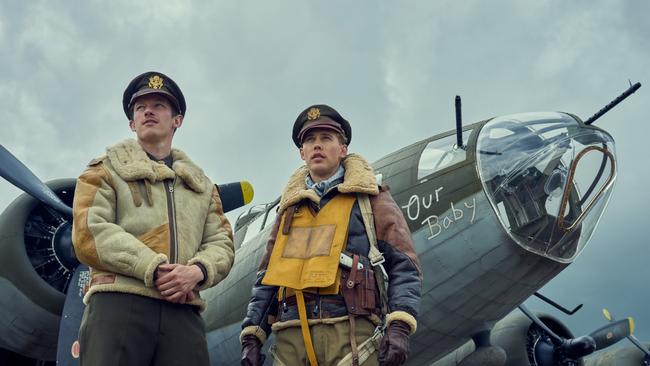Austin Butler stars in Masters of the Air, must-see TV series
Camaraderie is at the centre of Masters of the Air, the long-anticipated, expansive, action-packed nine-part series about a group of legendary World War II pilots in the Eighth Air Force.

“Combat fog obscures your fate – obscures when and where you might die – and from that unknown is born a desperate bond between the men,” wrote Sebastian Junger in War, his extraordinary book about the nature of conflict and the terror and excitement of war. “That bond is the core experience of combat and the only thing you can absolutely count on.”
And camaraderie is at the centre of Masters of the Air, the long-anticipated, expansive, action-packed nine-part series created by John Shiban and John Orloff and produced by Steven Spielberg, Gary Goetzman, and Tom Hanks.
It’s the producers’ third dramatisation of combat following Band of Brothers, which looked at the way a rifle company somehow managed to survive Nazi-occupied Europe during the last year of World War II, and The Pacific, which viscerally dramatised the scope of the same war in a part of the world few Americans could find on a map.
As Spielberg says in an accompanying video to the new series: “It’s really important to create a kind of library where people can understand what it took to keep our country safe.”
The new show is largely based on historian Donald Miller’s book, Masters of the Air: America’s Bomber Boys Who Fought the Air War Against Nazi Germany.
It’s about a group of legendary World War II pilots in the Eighth Air Force, who given the nature of their deployment could expect to be killed in action, wounded or captured by the enemy. Their shared commitment to safeguard one another’s lives though was unnegotiable, their willingness to die for each other in the acrid stench of fear and cordite, a form of love.
They keep going into combat day after day, the odds so stacked against them, camaraderie is all that keeps them going. “Not wanting to let them down because the bond was so strong,” says Miller. “They knew that, without it, they couldn’t survive in the plane.”
And, quickly from the start of Masters of the Air, there is a sense that fate has jinxed the flyers of the Eighth Air Force’s 100th Bomb Group, soon to earn the moniker “the Bloody Hundredth”. It seems to suffer excessive losses in the skies above Germany, its pilots quickly both respected and pitied by fellow bomber crews. The grief and trauma of dealing with death in the skies daily takes its toll. As airmen of the so-called “Hard Luck Unit” they quickly learn every flight would see not just the demise of their friends but possibly themselves, victims of the thunderous German flak or malfunctioning aircraft. “I wanted to tell a story of combat from the perspective of the inside of the plane,” says Miller, who acts as a historical adviser to the series, “not a Tom Cruise-style story of aerial dogfights. In the bomber war, the major trauma was inside that thin aluminium tube.”

That aircraft was the Boeing B-17, better known as the “Flying Fortress”. It carried a crew of 10 and 2700kg of bombs, flying at 480km/h, often in Siberian cold at around 35,000 feet, for a range of 3000km. Its famous nickname, bestowed by an awed journalist, referred to the way, imposingly, it carried 13 .50 calibre M2 Browning machine guns to fight the Luftwaffe and possessed a fabled robustness for delivering its crew home.
With no actual B-17s suitable for flying, let alone available for a long film shoot, a year was spent building two replicas for the TV series, accurate down to the switches on the dashboard, and authentic enough to trick us into believing they could survive thundering flak and the gunfire of German fighters.
The budget for the series was colossal at around $350-400 million, each episode coming in between $27m to $30m, with a cast of more than 300 and a production list of hundreds (see end titles). The director was inventive Cary Joji Fukunaga, known for his work on No Time to Die and HBO’s True Detective, but he’s taken a back seat in promoting the series after accusations of alleged misconduct on his sets.
The first episode introduces us to Austin Butler’s Major Gale “Buck” Cleven and the man who will become his close friend Callum Turner’s Major John “Bucky” Egan as they prepare to leave for Europe in 1943 with the US Army’s 8th Air Force’s 100th Bomb Group.
They’re both debonair with the right Hollywood swagger but both different, Cleven telling an early girlfriend, “I don’t think John Egan’s the pen pal type”. Bucky’s the first to Europe, initially an observational pilot with another unit flying over Europe and having to save a man’s life in mid-flight. “Are they all like that?” he asks another pilot on return to base at Thorpe Abbotts in East Anglia.
When Buck arrives, we’re also introduced to navigator Lt Harry “Cros” Crosby (Anthony Boyle) who will provide the clarifying narration for the episode, largely based on the real Crosby’s 1993 memoir of his experience in the Bloody Hundredth called A Wing and a Prayer.
Crosby suffers from terrible airsickness, so chronic a fellow airman says after one flight “Your stomach has to be as empty as our fuel tanks.” (It’s a human flaw that makes Crosby instantly relatable in character terms unlike the others who, at least at the start, fail to completely transcend traditional heroic war movie cliches.)
This is all to prepare for the main storyline – the group’s first major combat mission against targets in Bremen. And it’s a brilliantly filmed piece of combat action, drawing power from what writer Stephen Hunter calls “the charisma of brutality”, turning the viewer into the eleventh member of Buck’s crew.
It’s a sobering baptism of fire for our heroes as the massive formation of aircraft is soon a mess, engine problems beset the group, and the flak starts to explode, the lethal black clouds filling the sky.
“Why didn’t you tell me it was like that?” Cleven asks Bucky on his shaken return. “I didn’t know what to say,” he replies. “We got a long road ahead of us,” says Buck. The spectacle is simply astonishing, the camera crew led by True Detective’s Adam Arkapaw making full use of the replica planes and cockpits built for the actors who experienced the same restrictions and claustrophobia of the real airman.
Here is how they achieved those extraordinary action sequences in case you’re wondering as most viewers undoubtedly will ...
The planes were surrounded by what’s called on-set virtual production or The Volume, a form of entertainment technology which includes a series of LED panels that are used as a backdrop on set, and which display videos and images in real time.
It’s a circular studio really comprised of these high-definition panels all around, including the ceiling, onto which were projected the German fighters and the flak from the anti-aircraft guns through which the American airmen flew. So the actors are actually in the scenic world their characters inhabited on those long flights, able to act naturally to the changing circumstances.
Inside this virtual studio were the replicas mounted in the sky on giant gimbals, pivotal supports that permit rotation of objects around an axis, rather like a theme park ride, mounted with up to 80 cameras. The planes react to the simulated battle conditions, created by advanced computer-generated technology, as if in real time.
At times though it’s all so claustrophobic it numbs you, becoming tiring to watch. Hours of complexity and tragedy are condensed into five-minute montages. And even in the first episode the aerial fights tend to blend into each other. It’s hard too, to maintain any emotional connection to the characters given they are all indistinguishable in their rugged sheepskin padded leather jackets, parachute harnesses, life vests, oxygen masks and headsets.
This was a problem The Pacific had, too, at the start. Because the filmmakers wanted to capture the raw barbarism of what those fighting in their claustrophobia saw and felt, most battle scenes were filmed at night. It was tough to make out what was going on, and it’s the same with Masters of the Air.
The fog of war is deep indeed.
Masters of the Air, streaming on Apple TV+



To join the conversation, please log in. Don't have an account? Register
Join the conversation, you are commenting as Logout